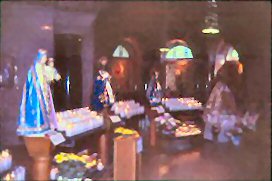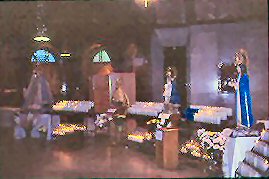The Philippine Madonnas
Home
Page
Introduction
 It is through Mary that we have received
Jesus, the Son of God who died on the cross to redeem
everyone. Mary offers us the loving concern each mother
has for her children, and because she is our spiritual mother,
she stands before the throne of the loving God solicitous for
our spiritual and physical welfare.
It is through Mary that we have received
Jesus, the Son of God who died on the cross to redeem
everyone. Mary offers us the loving concern each mother
has for her children, and because she is our spiritual mother,
she stands before the throne of the loving God solicitous for
our spiritual and physical welfare.
Over the years,
many have asked for her help. Sometimes she gives her aid
immediately. At other times, after calm reflection, we can
discern the hand of a loving mother protecting her children from
danger. Always, she prepares us for the opportunity to
accomplish greater tasks for God's glory.
History
Through the
fourteenth century, Italian merchants controlled the trade
routes from the East to Europe, and gathered large profits from
their merchandise. Spices, precious stones, medicines,
dyes, cloth, glassware, porcelain and rugs were in great demand
and claimed high prices. But new inventions like the
magnetic compass and instruments which measured latitude made
sea travel safer and led other nations to discover their own sea
routes to share in the wealth from this trade.
 Portuguese navigators sailed southward around the
tip of Africa toward the East while Spanish explorers sailed
westward across the Atlantic. With the discovery of the
new continent by Christopher Columbus, which was named after
Amarigo Vespucci, Spain claimed the right to explore and settle
its New World along with the Philippines which they
conquered. Although the Spanish monarchs, Ferdinand and
Isabella gave instructions that the natives and their
possessions be treated kindly, Spanish officials often used
harsh means to enslave the native peoples and obtain their
wealth. Spanish missionaries were sent to convert the
natives, and introduced religious devotions which the people
flavored with their own particular local and national
traditions. For this reason, one finds devotions to Mary,
her statues and pictures, and the robes with which her image
is adorned reflecting not only a Spanish influence, but
also the local Filipino flavor which portrays her as a loving
mother, provider, guide and protector.
Portuguese navigators sailed southward around the
tip of Africa toward the East while Spanish explorers sailed
westward across the Atlantic. With the discovery of the
new continent by Christopher Columbus, which was named after
Amarigo Vespucci, Spain claimed the right to explore and settle
its New World along with the Philippines which they
conquered. Although the Spanish monarchs, Ferdinand and
Isabella gave instructions that the natives and their
possessions be treated kindly, Spanish officials often used
harsh means to enslave the native peoples and obtain their
wealth. Spanish missionaries were sent to convert the
natives, and introduced religious devotions which the people
flavored with their own particular local and national
traditions. For this reason, one finds devotions to Mary,
her statues and pictures, and the robes with which her image
is adorned reflecting not only a Spanish influence, but
also the local Filipino flavor which portrays her as a loving
mother, provider, guide and protector.
Today
In 1985, the
late Jaime Cardinal Sin of the Philippines brought eight images
of the Madonna from the provinces to the United States for
display and veneration at the Basilica of the Shrine of the
Immaculate Conception in Washington, D.C. Their pictures
which follow are accompanied by a brief description of the
history of each which illustrates how our loving mother has
cared for all of her children throughout the world.
Personal
devotion of Our Lady is as varied as the ways any loving mother
would care for, guide, and protect her children. Because
of Mary’s position as the Mother of God, the Holy Spirit who is
her spouse, responds to our prayers, petitions, and the daily
needs in our lives. The story of the Philippine Madonnas
is a story of devotion, trust, and love for Mary who, like all
mothers, desires the best for her children, which is to lead us
to Christ, her Son.
Click on Mary's
titles to learn the story of each
Our
Lady of the Candle (Señora de Candelaria)
The
Feeding Lady (Señora de Namacpacan)
Our
Lady of Guidance (Señora de Guia)
Our Lady of Peace and Good
Voyage (Señora de Antipolo)
Our Lady of The Rosary (Señora del Santissimo
Rosario de Manaoag)
Our
Lady of Caysasay (Señora de Caysasay)
Our Lady of Peñafrancia de Naga
(Señora de Peñafrancia de Bicol)
Our
Lady of Poon Bato (Señora Poon Bato in Botolan, Zambales)
 It is through Mary that we have received
Jesus, the Son of God who died on the cross to redeem
everyone. Mary offers us the loving concern each mother
has for her children, and because she is our spiritual mother,
she stands before the throne of the loving God solicitous for
our spiritual and physical welfare.
It is through Mary that we have received
Jesus, the Son of God who died on the cross to redeem
everyone. Mary offers us the loving concern each mother
has for her children, and because she is our spiritual mother,
she stands before the throne of the loving God solicitous for
our spiritual and physical welfare.  Portuguese navigators sailed southward around the
tip of Africa toward the East while Spanish explorers sailed
westward across the Atlantic. With the discovery of the
new continent by Christopher Columbus, which was named after
Amarigo Vespucci, Spain claimed the right to explore and settle
its New World along with the Philippines which they
conquered. Although the Spanish monarchs, Ferdinand and
Isabella gave instructions that the natives and their
possessions be treated kindly, Spanish officials often used
harsh means to enslave the native peoples and obtain their
wealth. Spanish missionaries were sent to convert the
natives, and introduced religious devotions which the people
flavored with their own particular local and national
traditions. For this reason, one finds devotions to Mary,
her statues and pictures, and the robes with which her image
is adorned reflecting not only a Spanish influence, but
also the local Filipino flavor which portrays her as a loving
mother, provider, guide and protector.
Portuguese navigators sailed southward around the
tip of Africa toward the East while Spanish explorers sailed
westward across the Atlantic. With the discovery of the
new continent by Christopher Columbus, which was named after
Amarigo Vespucci, Spain claimed the right to explore and settle
its New World along with the Philippines which they
conquered. Although the Spanish monarchs, Ferdinand and
Isabella gave instructions that the natives and their
possessions be treated kindly, Spanish officials often used
harsh means to enslave the native peoples and obtain their
wealth. Spanish missionaries were sent to convert the
natives, and introduced religious devotions which the people
flavored with their own particular local and national
traditions. For this reason, one finds devotions to Mary,
her statues and pictures, and the robes with which her image
is adorned reflecting not only a Spanish influence, but
also the local Filipino flavor which portrays her as a loving
mother, provider, guide and protector.